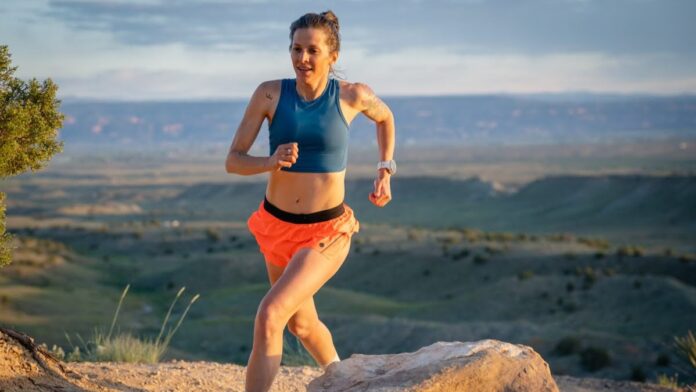[ad_1]
In last month’s article, we outlined the concept of pelvic rotation: how pelvic rotation loss can cause stubborn and seemingly intractable hip mobility deficits, alignment asymmetries through the rest of the leg, and perpetuate chronic aches and pains throughout the body.
Specifically, we discussed pelvic external and internal rotation. These are subtle but crucial motions where the pelvis:
- Externally rotates by opening in the front (slightly gapping the pubic joint) and closing in the back (slightly compressing the sacroiliac joint)
- Internally rotates by closing in the front (slightly compressing the pubic joint) and opening in the back (slightly opening the sacroiliac joint)
The imagery below helps to demonstrate the pelvis’s internal and external rotation.

Rear and top views of the pelvis bones and sacrum, depicted with foam shapes. (Note: For simplicity, the anterior pubic joint articulation is omitted from these foam models.)
This article will identify two key, strength-based exercises to maintain and promote pelvic rotational mobility: the Extreme Clamshell and the Wall Tap Hip Hinge.
Strength Maintains and Promotes Range of Motion
We lose functional mobility for many reasons: stiffness from repetitive use, inflammation and distortion from trauma such as falls, and more subtle factors like tissue dehydration.
We can regain tissue mobility from passive methods, including stretching and massage, and higher-force strategies like joint manipulation. However, to maintain — and further promote — any functional range of motion requires strong, coordinated muscle contraction through that range.
And because most pelvic motions are subtle and intimately connected to the hip, it takes specific, multi-dimensional strategies to promote pelvic rotation. To do so, we must isolate pelvic motion by first taking the hip into multi-dimensional motions, often at the end of the motion’s range. Only then can the pelvis — and how it articulates with the sacrum and trunk — be isolated to move.
The following are two exercises to promote pelvic external and internal rotation, respectively:
Pelvic Rotation Exercise #1: Extreme Clamshell
What it does: This exercise promotes pelvic external rotation and stretches the front of the hip.
To perform:
- Lie prone with your stomach on the floor.
- Slide one leg outward and upward, into a flexed knee, frogleg position.
- Continue flexing the leg upward while maintaining the pelvis — at the pubic bone — and the inner thigh as close to the floor as possible without lifting. When it begins to lift, stop flexing the hip.
- To actively open, lift the bent knee toward the ceiling, without allowing the rest of the body to lift. Hold for 5 seconds, then slowly lower.
- Repeat to fatigue, which is when you can no longer move the leg and pelvis without the body moving.
Benefits: In addition to promoting pelvic external rotation, this exercise also helps to:
- Improve functional hip flexion. Pelvic and hip external rotation is part of the three-dimensional running hip flexion pattern. Restoring external rotation also promotes full flexion.
- Optimize leg alignment. In people with knee valgus — a condition where the knee joint bends inward — pelvic external rotation is often lost. Efficient rotation helps the whole leg align efficiently.
This video demonstrates the Extreme Clamshell and the concept behind it:
Pelvic Rotation Exercise #2: Wall Tap Hip Hinge
What it Does: This exercise promotes pelvic internal rotation and stretches the posterior hip.
To Perform:
- Stand approximately one foot’s length — plus or minus to strength and comfort — from a wall with your back facing the wall.
- Balance on one foot.
- Hip hinge by sending your pelvis back toward the wall, while your trunk hinges forward over the stance knee.
- To orient into internal rotation, aim to only touch the stance leg buttocks on the wall. The swing hip, pelvis, and leg should oppose the movement by reaching forward, away from the wall.
- Slowly lower and shift backward until only the stance pelvis touches the wall. Pause for 1 second, then extend at the hip and knee to return to standing.
- Repeat to fatigue, which is when you can no longer maintain the internal rotation, lose hip hinge, or cannot touch the wall without losing balance.

The Wall Tap Hip Hinge exercise is demonstrated by an image of the starting position on the left and an image of the hip tapping the wall on the right.
Benefits: Besides promoting pelvic internal rotation, this exercise also helps to:
- Improve running-specific hip internal rotation, a key movement in functional leg extension in the push-off phase of running.
- Improve gluteal activation and strength as the internal rotation of the hip and pelvis applies an elastic stretch to the glute complex to promote better muscle activation.
- Improve balance as stretching the posterior hip helps the femoral head maintain efficient and stable alignment in the pelvis.
And this video demonstrates the Wall Tap Hip Hinge exercise and the concept behind it.
Conclusion
Pelvic rotations are subtle but powerful aspects of a runner’s mobility, alignment, efficiency, peak strength, balance, control, and, ultimately, performance. To optimize your pelvic motion and alignment, first monitor for stiffness and imbalances in other motions in the hips, knees, and ankles.
If stiffness and imbalance are resistant to local stretches, try the Roll-and-Reach exercise to assess for and improve mobility. Then, reinforce that motion with these specific strength exercises.
Good luck!
Call for Comments
Give these exercises a shot and let us know how they work for you!
[ad_2]









